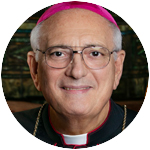
Bishop Nicholas DiMarzio
Recently, two international issues have produced refugees wishing to come to the United States. First was the fall of Afghanistan when the U.S. admitted nearly 80,000 individuals, either through a parole entry or because of other equity they had under immigration law.
The war in Ukraine has also produced 5 million refugees. Most are now in neighboring European countries. However, there are about 2,000 at the U.S.-Mexico border.
President Joe Biden has already announced that the U.S. is willing to take 100,000 Ukrainian refugees. Therefore, it might be good to understand the refugee resettlement process and program.
The Catholic Church has been involved with refugee resettlement in a large-scale, organized way ever since World War II, when millions of displaced people in Europe were resettled in various countries.
The U.S. Conference of Catholic Bishops established a department called Migration and Refugee Services designated by the U.S. State Department as a national voluntary agency among other religious and secular groups.
[hotblock]
MRS has usually been the resettlement agency with the greatest number of refugees, because of the capacity of our diocesan Catholic Charities and locations throughout the U.S.
I am very familiar with the process. I began refugee resettlement work in 1976 after the fall of Vietnam when my diocese designated me as resettlement director of Catholic Charities for the Archdiocese of Newark, New Jersey. In 1985, I became the national director of MRS.
The process has not substantially changed over the years. Once a refugee leaves their home country and finds asylum or refuge in another country, they can apply to the United Nations refugee agency, UNHCR, for designation as a refugee. The resettlement countries around the world — mainly the U.S., Canada and Australia — select refugees appropriate for their own countries.
There is a rigorous screening process, which has become even more complicated recently because of terrorism concerns. It normally took two and a half years, and now it takes up to four years. Medical screenings are done, political affiliations are researched, reasons for seeking residence and many other issues are vetted before someone is accepted for the U.S. resettlement program.
The Department of State accepts refugees from UNHCR and distributes them to national voluntary organizations. The agencies are paid a small per capita grant for the processing and are required to find resettlement locations. The sites must have housing, jobs and integration services.
MRS maintains about 40 sites in dioceses with a Catholic Charities where they can resettle refugees allocated to them. But given the massive new influx of refugees, the system needs to be expanded. This will depend on willing dioceses and Catholic Charities organizations, parishes and volunteers.
Unfortunately, this formal program is not presently being used to resettle Ukrainian refugees in meaningful numbers. On April 21, the U.S. announced an initiative called Uniting for Ukraine, which will rely primarily on the use of humanitarian parole — as was done for many Afghans.
Humanitarian parole offers temporary authorization to enter the country, but it does not guarantee individuals the ability to permanently reside in the U.S., nor does it provide them access to most services or benefits available to conventional refugees.
Although some may wish to return to Ukraine, it would be difficult for most to be integrated into American communities without being formally accepted as refugees.
This is why, following the announcement of Uniting for Ukraine, the USCCB has called for the Biden administration and Congress to work together to ensure Ukrainians seeking refuge and other displaced persons in the U.S. are truly welcomed and receive necessary support.
***
Bishop Nicholas DiMarzio is the retired bishop of the Diocese of Brooklyn, N.Y. He writes the column “Walking With Migrants” for Catholic News Service and The Tablet.



Share this story